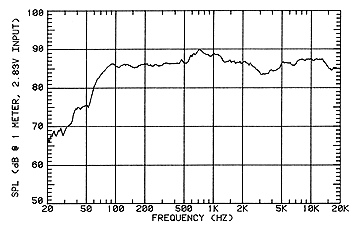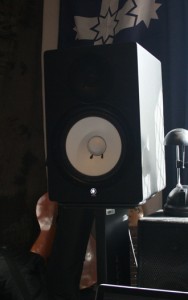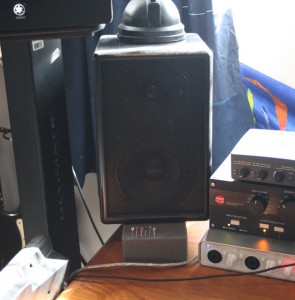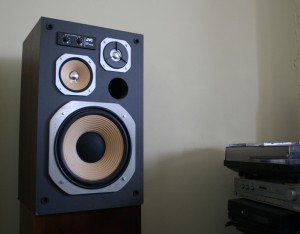Monitoring For Gold: Triangulation For Final Mix Translation
Nod your head if you've ever gone through this: You've made a fabulous tune and stayed up all night mixing until it sounds really pro. You drop a copy to mp3, go to your friend's place and play it to them. Out of the speakers pours the most embarrassing mess of sonic sludge ever accidentally spewed forth by the gods of low fidelity! Yep, I see a few heads nodding. Even worse, your friend might have said to you that you need a pair of insanely expensive monitors and a million dollar studio before you can even dream of getting a good mix. Bah, what kinda of friends are they? I say the idea is rubbish! Although, wouldn't we all like an amazing studio to work in? Nevertheless, the reality is this: it is perfectly reasonable to get a first rate, excellent mix of your song – just helps to know some monitoring tricks to make the attempt.
This article deals with how to use speakers to get a great final mix for your song. And you may be surprised to see just how low budget you can pull this off with. Regarding technicalities with software, it is ideal that your read my other recent In:Depth article on avoiding clipping. Especially read in regard to setting playback loudness levels. The approach addressed below can be applied for mixing in Renoise, but also in any other DAW or mixing projects.
The need for a final mix
I like to think of a good final mix as equal parts 'creative art' and 'scientific balance'. I'm assuming that you have the 'creative art' aspect of the deal well established. This part is your compositional ideas, your choice of sounds, instrumentation, transitions, effects and sonic shape of your music. These are the elements that give your song unique character. Think of them as indisputable, and as the representatives of your intentions as an artist.
The second part of what qualifies for a good final mix is what was once strictly the domain of mix engineers: the precise and refined shaping of the sound in a near-scientific balance and flow. Any mix engineer worth their fee would honour the 'creative art' of the mix. They use tools like volume, pan, EQ, and compression to focus and clearly present the music. Many engineers weren't actually creative musicians, but more like technical craftspeople who would approach a mix analytically with great skill using the best equipment possible. These technicians eventually had it very lucky, because their great sounding equipment and production procedure made it more and more effortless to get a very good result. Given this, why should it be so hard for you?
These days you can attempt it all yourself using Renoise on a computer in your bedroom. Where a lot of home producers run into problems is not being able to make the transition from 'creative art' to 'scientific balance', or even knowing they might need to make that transition. These two parts of production require radically different mind-sets and skills; but of course no one tells you that when you start making your own music. This is why it is ideal for home producers to break up the production into these two distinct parts: first the art, then once the art is complete the final mix sessions can begin. Even better is to distance that final mix session work well apart from the creative stage, so there is no temptation to go back into the song and add indecisively. Separate production stages help the mind focus on different processes and issues. It gives you a better chance at making that final mix one that has had some dedicated and well thought-out work done on it.
The better a final mix is the easier and more natural the mastering of the music. Mastering is a whole other technical area, and I will discuss this in future articles. For now, it is important to understand that good final mix prepares the sound for a good mastering. The mix has headroom and no clipping. It will lack excess and unnatural emphasis in any frequency.
All well and good, but what about all that tweaking and fine tuning to get things clear and balanced? You might feel a little daunted and have no idea where to start with all these volume settings, panning settings, EQs, and compressors. For example, just look at EQ10 in Renoise: there are 30 different parameters to tweak and hope that what you're hearing is doing the sound some benefit. So many parameters, what to do with them all? To help guide us, we need to look at a phenomenon called 'translation'.
Defining translation
Some of you might know the science fiction series The Hitchhiker's Guide To The Galaxy. In this story there is a thing called a Babel Fish, which is a small fish people put in their ear. The fish amazingly translates any language in the galaxy into whatever language the fish's person understands. Now, wouldn't it be neat if there were such a thing that could do this for our mixes? Well, last time I checked there isn't Babel Fish you can buy that automatically translates sloppy mixes into audio-gold – but the good news is there is a way of doing this yourself to get best results on any speakers.
This achievement is called translation. Translation is where the mix is clearly balanced and organised so that it sounds great and understandable on any speaker system. It is like the 'ideal packaging' the delivers the product (being the creative ideas) in the cleanest and most efficient way possible. Translation is genre agnostic. Crazy noise music can be expressed just as clearly and beautifully as the softest whisper of acoustic recording or programming. It never holds the intention of sounds back, but rather presents them in a way that is unmasked, organic and sonically pleasant. Mixes that have achieved translation tend to also have a longevity to them – you can listen to them over and over again and your ears do not tire from the sound.
Translation can be mostly achieved at the final mix stage. The more you achieve in the mix, the less you have to squeeze and contort in the mastering. So now, you know you're using your Renoise mixing effects to try and tweak things to get this phenomenon called translation. But, before you even begin tweaking, you need to consider how you are using the very things that reproduce the sound you are trying to shape. Speaker monitors.
One set of monitors: the pitfalls
All sets of speakers have a frequency response. This is a measure of how accurate the speakers represent all the audible frequencies: from subs, to bass, to mids, and to highs. If the speakers have been tested scientifically, then the response of the speakers can be graphed like so:
Some speakers have a more 'flat' looking response than others. The flatter the response, the better the speakers are for accurate monitoring of your sound. Generally speaking, small consumer and hi-fi speakers don't have the flattest response in the world; and sometimes they even over-emphasise certain areas to make them more marketable. Professional studio monitors are usually made of higher grade material and technology, and have a flatter response. But, there are absolutely no set of speakers out there that have a dead flat, 100% perfectly accurate response. They don't exist! So even if you're buying a $20,000 set of monitors, you're still getting an imperfect representation of the sound.
Additionally, different sets of monitors have different 'dynamic response'. This is the measure of how accurately they represent the dynamics of the sound (the transitions between loud and quiet). In my experience, some speakers sound 'shallow', while others are more 'expressive'.
Add also to the equation the aspect of amplifier colour. Any signal that passes through circuitry that has op-amps will be coloured. There are solid-state transistor colours, as there are a large variety of tube amp colours. And, there are different amp designs that produce different colours. A whole rainbow of confusion!
To make matters even more complex every single room in sounds different. This is the realm of acoustics: the frequency response of a room. Frequencies bounce around in room producing resonances and cancellations, which in turn distort the perception of the flatness of the sound. Mid and high frequency reflections also make the room more lively, making it difficult to understand the dynamics. Of course, professional studios are treated to manage acoustics, and there are many schools of thought on how to best do this (more on this in another article). But even with the best treatment in the world, the room will still be imperfectly unbalanced in some regard.
Factor in all of the above, and then make the consideration that some engineers and producers insist on on using only one set of monitors! Can you believe it? Sure, there's some weight to the point that 'knowing your gear well' helps you work out a good sound, but why risk it? Unless you know your monitors utterly and absolutely, it is going to be difficult for you make a good final mix happen, let alone achieving translation.
The pitfalls are as follows. Where your monitors, gear and acoustics under-represent a frequency (e.g. a bass sounds less than it actually is) you will tend to over-emphasise that part in your mix. The reverse is true: if your gear is over-stating a frequency then you will naturally hack back at it and scoop it too much out of your mix. The more you become reliant on a deficiency the more you develop bad habits that ruin mixes. I think it is safe to wager that 99.99% of us are working with gear and environments that aren't 99.99% flat – so why would we limit ourselves to just one set of monitors who steer us into one way of working?
The trick is use more than one set of monitors. Routinely.
Triangulation
I'm not sure if this term has been coined elsewhere, but I call this method of using more than one set of monitors 'triangulation'. A triangle has three sides, so I use no less than three sets of monitors to balance out and cancel out any biases I have from one set. The triangle analogy also works well for the ideal listening position for near-field monitors: at equal hight to your ears in a triangle pointing the speakers at your head. So whenever I am doing a final mix and trying to achieve translation, I do so by checking the mix through triangulation.
I have some personal rules for triangulation. One set of monitors must be large-diaphragm enclosed headphones, preferably of reputable quality. Another set must be some reliable, and flat as possible near-field monitors, preferably on stands in an acoustically treated room of a largish size. A third set of loud hi-fi speaker (or near-fields if you have them) should be used in a different room (again a large room is better at volume). Optional extras include: a second set of near-fields in the studio; laptop speakers; earbuds; and car stereo. However, these last few are not reliable for editing work, only 'end checking'.
Here is a breakdown of my own final mix routine. I do most of my mixing work on my headphones, which currently are AKG K240 mkII. I do a lot of that mixing at fairly low volume in a quiet environment. This is so I preserve my ears, and efficiently do a lot of obvious or general editing. The 'cans' are really good for setting dynamics. Good headphones are also ideal for really tightening up the placement and expression of low frequencies, as you're getting no acoustic interference. I do a lot of general listening to CDs of all genres on my headphones, so I really know what a good low end frequency image feels like. Incidentally, I really recommend headphones for composition, as they are great for really getting immersed in the sonic universe of your song and being creative with that.
Once I'm happy with the headphones I move the mix onto my Yamaha HS80Ms, which are on sand filled stands in my acoustically treated project studio. The pandas (my nickname for the monitors) have 8” bass drivers, so they give a very open representation of the low end that I like and tend not to feel from 6” drivers. In the tradition of the Yamaha's NS10s, these monitors are bright and full on with the upper mids, so they are great for detailed EQ work in tempering excess in those areas. The mix is checked at different volumes to get an accurate sense of dynamics and the inertia of frequency ranges. I also sum the mix to mono to check all the volume placements, and then back to stereo to fine tune the pan positions or other spatial effects.
Then I move onto a second set of near-fields I have, which are in the same room, on foam and upon my desk. These are my old custom-built monitors running on a budget Class AB 50W amp. They only have 4” bass drivers, and man do the high frequencies rip and squeal! They are just about downright painful to listen to, but are very handy for double checking excess in top frequencies as well as how well kicks and basses are articulated on gutless speakers. A check on these doesn't take too long.
Finally I'll take the mix out to our living room, which is a long large room, with an odd shape and no acoustic treatment. There I have a Class A Technics SU-700 amp hooked up to two JVC SK-700II hi-fi speakers. I play the mix loud and annoy the neighbours! These speakers have a very soft, musical and dynamic quality to them. They are a joy to listen to music on for hours and hours. I use them as a final check for translation as well as to see if I got the brightness of the mix present enough. If I hear anything amiss, I go back to the studio with fresh ideas on how to tighten things up.
Using this triangulation, I can achieve final mix translation. I can take a mix-down and play it anywhere knowing it will work. Then I can graduate the song to the mastering stage. And you know what? I use exactly the same triangulation method in mastering as well!
You don't have to go out and buy all the same gear I have and use it in the same way. The main point is that you use at least the three of the most reliable monitoring methods you have available to you. By all means, if you have a lazy $20,000 to go spend on an amazing set of monitors, go right ahead! But without checking your mix systematically on two other sets of speakers, then you can only be guessing if you've got translation or not. I think you will find that you don't need an outrageous budget to set this situation up.
Final checks
Using triangulation in your monitoring procedure will help you begin the task of accurately using the Renoise mixing tools such as volume, panning, EQ and compression. The specific use of all these tools could produce a whole article for each technique and each situation. No point in beginning to learn all those tools without a reliable monitoring method.
You'll know when you have translation: the mix will have an open and clear feel. It will feel like it just 'works'. A final mix doesn't have the full punch, width and brightness a mastered track can have – but it will feel absolutely 'safe' and well presented. All the averaging you will have done across different monitors will reveal the gold.
Go forth and experiment. Find an adaptation of these ideas for your own situation. Then, hopefully you'll be able to share those mixes with friends and online without fear of unwanted sonic surprises.
- mr_mark_dollin's blog
- Log in to post comments














18 comments